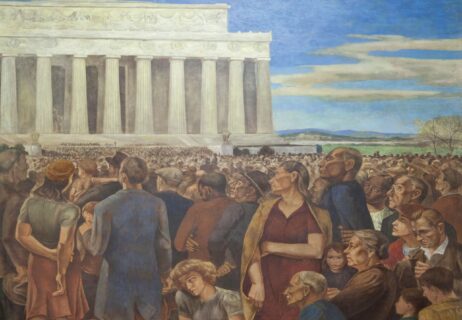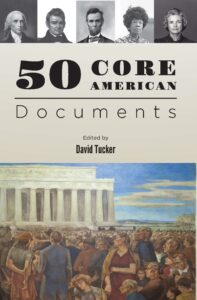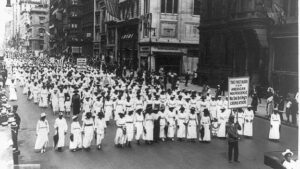
Introducing 50 Core American Documents, 2nd. Edition
50 Core American Docs: An Introduction

50 Core American Documents is an introduction to both American history and to the Core Documents project of Teaching American History. As an introduction to American history, it focuses on several key themes or ideas that have shaped our history, including:
- Equality and liberty
- Race and civil rights
- Religion and politics
- America’s uniqueness and place in the world
- The relationship between the states and the federal government
- The relationship between the federal government and the daily lives of Americans.
(Appendix C, the Thematic Table of Contents, lists the documents according to theme.)
It presents these themes and ideas as Americans thought about them when the United States was an agrarian republic, as it developed into an industrialized nation-state, and as it most recently struggled with the consequences of its success in creating a globalized economy and liberal international order that, to a remarkable degree, reflects the guiding principles of its own continental expansion. Those guiding principles were, in turn, formed from the central principle of all American history and politics—human equality—as expressed in the Declaration of Independence.
The Declaration is not placed among the fifty core documents in this collection for the simple reason that listing it as one among many documents does not do it justice. It, or rather the self-evident truth it enshrined— “all men are created equal”—is the transcendent cause of all the other documents in the collection. It appears in an appendix, as does the Constitution, not as an afterthought but as a sign of its singular importance. The opening words of the Constitution, “We the people,” derive their status from the Declaration. If Americans had not believed in equality, then the opening of the Constitution might have been written “We the white people,” or “We the rich,” or “We the poor,” or “We the people of British descent,” or “We the Protestant people.” It is true, of course, that some Americans have tried from time to time to read the opening of the Constitution in such partial ways, but the original plain and profound declaration of human equality has so far defied such readings and prevented them from gaining final authority. Paradoxically, perhaps, as the documents in this collection show, no idea in American history has been so hard for Americans to understand or has caused them so much trouble as the self-evident truth of human equality.
If Americans had not believed in equality, then the opening of the Constitution might have been written “We the white people,” or “We the rich,” or “We the poor,” or “We the people of British descent,” or “We the Protestant people.”
Documents other than those in this collection might have been chosen with equal justification to illuminate its themes. That does not diminish the importance of those that were chosen, however. It merely testifies to the rich supply of documents we may choose from. We have omitted documents dealing with foreign policy because that is rightfully subordinate to the issues the selected documents deal with. Including a few documents on foreign affairs seemed unnecessary since the Core Documents collection currently includes American Foreign Policy to 1899 and The Cold War, and will include American Foreign Policy since 1899.
As an introduction to the Core Documents Collection, this volume uses documents and editorial material taken from other volumes. As do the other volumes in the collection, this volume provides a general introduction and introductions to each document to provide historical context. Each document has been checked against an authoritative source to ensure accuracy and has been annotated to identify people, events, movements, or ideas that may be unfamiliar. In addition to the thematic table of contents already mentioned, every volume contains in an appendix one set of study questions on the document and another that refers to other documents in the collection, tying them together as the thematic table of contents does. Finally, all the volumes in the collection include an appendix with suggested further reading.
When completed, the Teaching American History documents collection will be a comprehensive and authoritative account of America’s story, told in the words of those who wrote it—America’s presidents, labor leaders, farmers, philosophers, industrialists, politicians, workers, explorers, religious leaders, judges, soldiers; its slaveholders and abolitionists; its expansionists and isolationists; its reformers and stand-patters; its strict and broad constructionists; its hard-eyed realists and visionary utopians—all united in their commitment to equality and liberty, yet all also divided often by their different understandings of these most fundamental American ideas. The documents are about all this—the still unfinished American experiment with self-government.

50 Core American Docs: Table of Contents
- Benjamin Franklin, Autobiography, 1771–1790
- Virginia Declaration of Rights and Constitution, June 12, 1776
- Chief Justice William Cushing, Commonwealth v. Nathaniel Jennison, April 1783
- James Madison, Memorial and Remonstrance, June 20, 1785
- The Three-Fifths Clause, June–August 1787
- The Northwest Ordinance, July 13, 1787
- Brutus I, October 18, 1787
- Publius (James Madison), Federalist 10, November 22, 1787
- President George Washington, Letter to the Hebrew Congregation at Newport, August 18, 1790
- President Thomas Jefferson, First Inaugural Address, March 4, 1801
- Representative James Tallmadge, Speech to Congress, February 15, 1819
- Secretary of State John Quincy Adams, An Address . . . Celebrating the Declaration of Independence, July 4, 1821
- John Ross, Address to the People of the United States, by the General Council of the Cherokee Nation, July 1830
- President Andrew Jackson, Veto of the Bank Bill, July 10, 1832
- Edward Beecher, “The Nature, Importance, and Means of Eminent Holiness throughout the Church,” 1835
- Abraham Lincoln, “The Perpetuation of Our Political Institutions” (Lyceum Address), January 27, 1838
- John L. O’Sullivan, “The Great Nation of Futurity,” November 1839
- Abraham Lincoln, The Temperance Address, February 22, 1842
- Senator John C. Calhoun, Speech on the Oregon Bill, June 27, 1848
- Seneca Falls Resolutions, July 19–20, 1848
- Frederick Douglass, “What to the Slave Is the Fourth of July?” July 5, 1852
- Abraham Lincoln, Speech on the Repeal of the Missouri Compromise, October 16, 1854
- Chief Justice Roger Taney, Justices John McClean and Benjamin Curtis, Dred Scott v. Sandford, March 6, 1857
- Alexander H. Stephens, The “Corner Stone” Speech, March 21, 1861
- President Abraham Lincoln, Second Inaugural Address, March 4, 1865
- The Farmers’ Movement, 1873–1874
- W. G. Shell, The Shell Manifesto, January 23, 1890
- Plenty Horses Kills Lieutenant Casey, January 7, 1891
- Eugene V. Debs, Liberty: Speech at Battery D, Chicago, on Release from Woodstock Jail, November 22, 1895
- Justice Henry Billings Brown and Justice John Marshall Harlan, Plessy v. Ferguson, May 18, 1896
- Theodore Roosevelt, “The New Nationalism,” August 31, 1910
- Woodrow Wilson, “What Is Progress?” 1913
- W. T. B. Williams, “The Negro Exodus from the South,” 1919
- A. C. Dixon, “The Bible at the Center of the Modern University,” June 1920
- Harry Emerson Fosdick, “Shall the Fundamentalists Win?” June 10, 1922
- Franklin D. Roosevelt, Campaign Address on Progressive Government at the Commonwealth Club, September 23, 1932
- Herbert Hoover, The Consequences of the Proposed “New Deal,” October 31, 1932
- Justice Robert H. Jackson, Wickard v. Filburn, November 9, 1942
- President Harry Truman, Veto of the Internal Security Act, September 22, 1950
- Chief Justice Earl Warren, Brown v. Board of Education of Topeka, May 17, 1954
- F. L. Shuttlesworth and N. H. Smith, Birmingham Manifesto, April 3, 1963
- Ronald Reagan, “A Time for Choosing,” October 27, 1964…..
- President Lyndon B. Johnson, “To Fulfill These Rights,” Commencement Address at Howard University, June 4, 1965
- Representative Shirley Chisholm, “For the Equal Rights Amendment,” May 21, 1969, and August 10, 1970
- McGovern-Fraser Commission, “Mandate for Reform,” September 22, 1971
- Jesse Jackson, “The Rainbow Coalition,” Speech to the Democratic National Convention, July 18, 1984
- Republican National Committee, Contract with America, September 27, 1994
- Justice Sandra Day O’Connor and Justice Clarence Thomas, Grutter v. Bollinger, June 23, 2003
- President Barack Obama, Remarks on the Economy, Osawatomie, Kansas, December 6, 2011
- Representative Paul Ryan, Acceptance Speech, August 29, 2012



